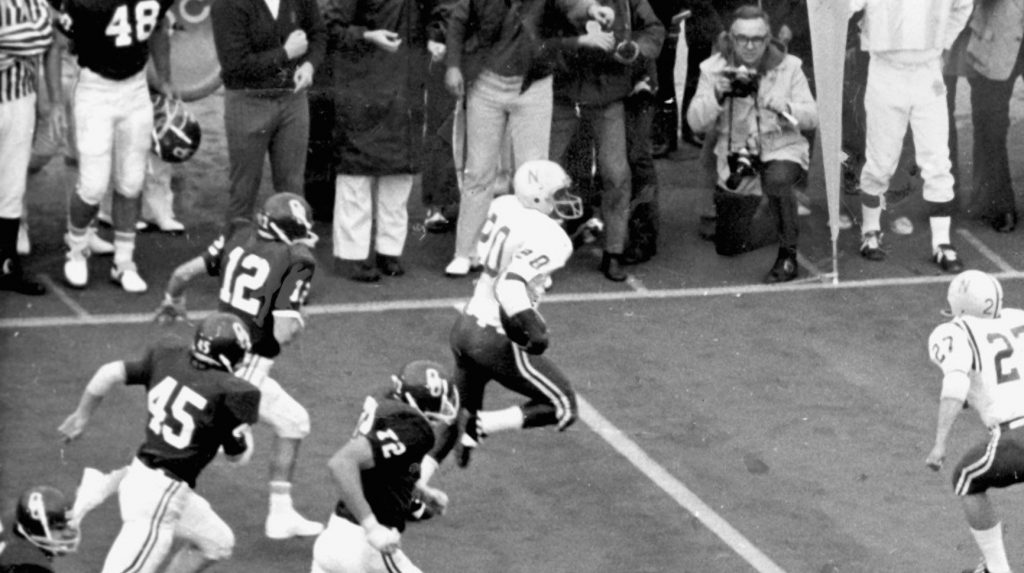
Meet Johnny Rodgers, Wide Receiver

You know the story: The Heisman Trophy was created in 1935 for the “most valuable football player in the East” by the Downtown Athletic Club of New York City. After the death of the club’s athletic director, John Heisman, the award was named in his honor. Jay Berwanger of Chicago was the first recipient.
In the decades since Berwanger, the trophy has grown in popularity and prestige and is now, arguably, the most recognizable trophy in American sports.
But for much of the first 70 years of the trophy’s existence, the infrastructure supporting the preservation and recording of the trophy’s history was limited. After all, the DAC was a social club, not a true sports organization.
And, so, a few items slipped through the cracks over the years. Namely, the idea that 1972 Heisman winner Johnny Rodgers of Nebraska was a running back.
The Cornhusker legend has been labeled in Heisman literature ever since he won the award. As a result, the idea has been widely promulgated that (a) running backs won the Heisman every year between 1972 and 1983 and that (b) the first wide receiver (properly defined) to win the Heisman was Tim Brown in 1987.
The Heisman Trust has made an effort in the last couple years to clean up the historical record on Heisman winners and one conclusion we’ve come to is that Johnny Rodgers was a wide receiver.
It’s highly likely that the mistake was made because of the terminology of the Nebraska offense in that era. Rodgers’ official position was “wingback” and he occasionally lined up in the backfield to take carries. He even started at running back in the 1973 Orange Bowl. But, for the most part, he was either split wide or offset in the slot as a receiver. As shown in the formation below, Rodgers (and Irving Fryar a decade later) played the “W” position in the Nebraska offense:

Here’s a screen shot of Rodgers lined up wide in the 1973 Orange Bowl (he’s No. 20 at the bottom right):

The statistics also point clearly to Rodgers being a wide receiver. During his Heisman-winning season, he caught 54 passes for 919 yards and eight touchdowns. Yes, he also rushed for 268 yards and seven scores and was a dynamo on punt and kick returns, but the bulk of his 1,978 all-purpose yards came via the receiving end.
Finally, if that’s not enough to convince you that Rodgers is a wide receiver (if you even needed convincing), take it from the man himself, who said the following last December after being referenced, once again, as a running back (something he clearly did not appreciate):
“I’m a wide receiver. Period. It’s a mistake to say otherwise. I was what they call a ‘utility’ back. That means I was versatile. But wide receiver was my position and you can tell that because of the records I held at Nebraska for receiving. I did do a lot of running from the wing back spot, but the only time I actually ran from the I-back was against Army and against Notre Dame, my senior year. I was mostly split wide and occasionally played the wing back or slot back.
“It means I was the first wide receiver to win the trophy. You can tell by my records and by my yardage what I predominantly did — and I was a wide receiver. Just the other night they said there have been only two wide receivers to win it and that Tim Brown was the first. But I was the first wide receiver.
“I could catch a BB in the dark with no moon and with my sunglasses on. That makes me a wide receiver!”
We agree, Johnny. We agree.
For the record, this now means that there have been three true wide receivers to win the Heisman: Rodgers in 1972, Brown in 1987 and Desmond Howard in 1991. Keep in mind that Larry Kelley of Yale (1936) and Leon Hart of Notre Dame (1947) were primarily pass catchers when they played on offense, but they lined up on the line rather than split out wide. They were, in essence, tight ends. Also, Charles Woodson caught 11 passes as a part-time wide receiver when he won the Heisman in 1997, but his primary position was cornerback.




